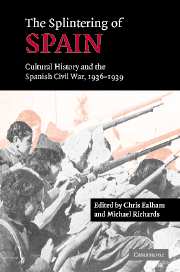Book contents
- Frontmatter
- Contents
- List of illustrations
- List of maps
- List of contributors
- Preface
- List of abbreviations
- Chronology
- Maps showing the division of Spain, 1936-1939
- 1 History, memory and the Spanish civil war: recent perspectives
- Part I Overviews: violence, nationalism and religion
- Part II Republican political and cultural projects
- Part III Identities on the Francoist side
- 8 Old symbols, new meanings: mobilising the rebellion in the summer of 1936
- 9 ‘Spain's Vendée’: Carlist identity in Navarre as a mobilising model
- 10 ‘Presenting arms to the Blessed Sacrament’: civil war and Semana Santa in the city of Málaga, 1936–1939
- Notes
- Index
8 - Old symbols, new meanings: mobilising the rebellion in the summer of 1936
Published online by Cambridge University Press: 28 July 2009
- Frontmatter
- Contents
- List of illustrations
- List of maps
- List of contributors
- Preface
- List of abbreviations
- Chronology
- Maps showing the division of Spain, 1936-1939
- 1 History, memory and the Spanish civil war: recent perspectives
- Part I Overviews: violence, nationalism and religion
- Part II Republican political and cultural projects
- Part III Identities on the Francoist side
- 8 Old symbols, new meanings: mobilising the rebellion in the summer of 1936
- 9 ‘Spain's Vendée’: Carlist identity in Navarre as a mobilising model
- 10 ‘Presenting arms to the Blessed Sacrament’: civil war and Semana Santa in the city of Málaga, 1936–1939
- Notes
- Index
Summary
The bombing of the Basílica del Pilar has not been just another episode in the struggle; it was a criminal and cowardly attack against the two most sacred and holy values in Spain; against the two postulates that support and encourage us, to the point of making us invincible, in the struggle to the death we are engaged in … a religious struggle, a true crusade of a people humiliated and offended due to their beliefs.
Thus read part of Martín Hernández's long article, published on 8 August 1936 in El Norte de Castilla, the day following a series of mobilisations and rituals held in the Castilian rebel heartland of Valladolid with, according to the newspaper, thousands of citizens participating. The cathedral was filled with people and the great majority of them, unable to enter the temple, remained in the adjacent streets. On 3 August the statue and dwelling in Zaragoza of Nuestra Señora del Pilar had been bombed by a plane belonging to the Catalan Generalitat. ‘Miraculously’ no great damage had been done. In the interior of the cathedral of Valladolid a few days later, the local authorities – the civil governor, the mayor and the president of the diputación (local council), all headed by Major General Andrés Saliquet – presided over the solemn act in homage to the Virgen del Pilar in an act of reparation.
- Type
- Chapter
- Information
- The Splintering of SpainCultural History and the Spanish Civil War, 1936–1939, pp. 159 - 176Publisher: Cambridge University PressPrint publication year: 2005
- 10
- Cited by



